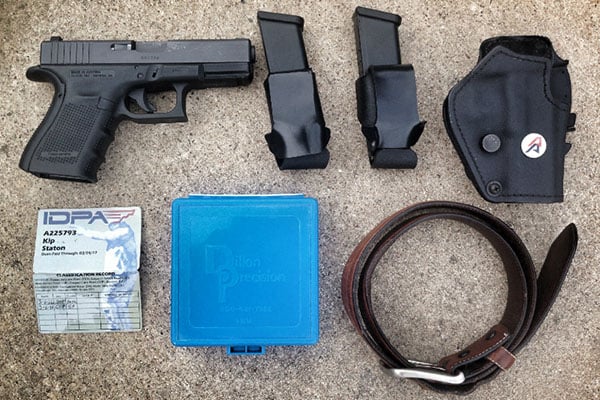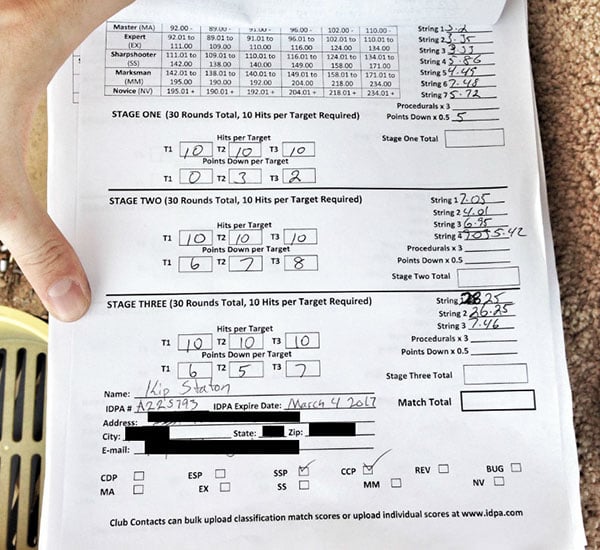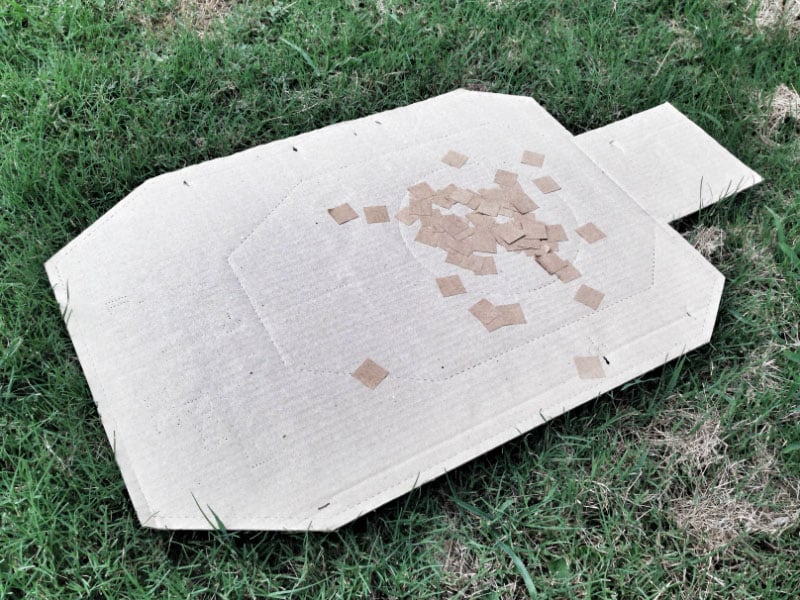
Last Updated on
By Kip Staton
I recently completed my first official IDPA classifier, and I came away with some impressions and ideas that might be helpful to others in similar circumstances.
I’m by no means an IDPA veteran. I’ve shot club matches for a few years that are “IDPA style,” but they didn’t necessarily hold to the gospel rules of the International Defensive Pistol Association. I’m pretty new to “official” IDPA matches. But here’s what I came away with.
First, What Is the IDPA Classifier?
Have you ever wanted to try your hand at an IDPA match, but felt that you would be wasting your time and ammo shooting against experienced gunslingers?
The classifier is meant to help with that. It gives shooters a way to compare their scores to others with similar capabilities and skill levels.
Shooters complete the 90 round course of fire over three separate stages, with final scores calculated based on your time, shots not in the central scoring zones (“points down”) and any other added penalty points for not following the rules. See the chart below:

This chart can be confusing at first, but it’s simple to break down. The vertical column on the far left is your potential classification. Don’t worry about the “CDP, ESP, SSP, etc.” along the top, for now. Those are simply different gun categories. After all, it wouldn’t be fair to have a revolver shooter compete against guys with tuned 1911s, no matter what experience levels are involved.
Your final combined score of time + penalties + points down will place you in one of the above time brackets. That’s your classification in that division!
It’s possible to classify in more than one gun division at the same time, if your pistol meets multiple division specifications. For instance, I classified in both SSP (Stock Service Pistol) and CCP (Compact Carry Pistol) by shooting my Gen 4 G19. However, I’m a Sharpshooter in CCP and a Marksman in SSP, because the time brackets are different and I missed the cutoff for SSP Sharpshooter by a fraction of a second. Oh well.
Your scores are recorded and calculated with a sheet like the one pictured below. These are my actual scores from the classifier match I shot:

Each stage requires 30 hits on the targets, and you can see that I successfully made them all… but slowly, and with multiple points down. The classifier is a balancing act between accuracy and speed.
What Do You Need To Shoot The IDPA Classifier?
If you regularly carry a handgun concealed, you likely already own everything needed to shoot the IDPA classifier:
- A gun
- At least two magazines (the more the better, this saves time reloading between strings of fire)
- Magazine pouches
- IDPA-legal belt (check the IDPA rule book)
- IDPA-legal holster (check the rule book again)
- 90 rounds minimum (bring more in case a re-shoot is needed for some reason)
- Membership in IDPA
While a cover garment of some type is required at nearly all sanctioned IDPA matches, it’s optional when shooting the classifier. And there are a few holster types that aren’t allowed (appendix holster, most notably).

I use my Gen4 G19, DAA PDR belt ride holster, and home-bent kydex magazine pouches when I compete. I really wish I could use my Raven Vanguard II appendix holster, as it’s been my daily carry choice for the past few years. But the rule book bans appendix carry out of concern for safety, so I make the best of it.
What You Do During the Classifier
The classifier is a 90 round course of fire, and it can be quite confusing at first glance. The good news is that there’s a method to the madness, and a closer examination will show that the classifier isn’t terribly complex.
The course is divided into three different stages, each consisting of 30 rounds. The first of these stages is shot at 7 yards, and the last one begins at 20 yards.
I won’t go into the nitty-gritty details of how the stages are set up and what the individual shot string requirements are. The IDPA website does a fantastic job of explaining it, complete with visuals. However, during the individual stages of the classifier, you will need the following skills. In no particular order:
- Safely draw your pistol from your holster.
- Shoot with your strong hand only.
- Shoot with your weak hand only.
- Reload from a completely empty gun with the slide back.
- Reload while retaining a partially depleted magazine.
- Shoot while walking forward.
- Shoot while walking backwards.
- Hit a dinner plate sized target at 20 yards.
- Shoot from both left and right side cover.
- Shoot while kneeling.
If you’re pretty good at doing those things, you’ll do just fine on the classifier. Don’t worry too much about memorizing the individual strings, although reviewing them is a good idea. IDPA match directors are very helpful and make sure that you understand what you need to do before you do it.
Scores are calculated pretty simply. As you can see on the target below, there are different perforated scoring zones marked out. Shots in the center circle and head box are scored as a “zero”, meaning no “points down” are incurred for hits in that zone.
The next scoring zone is the –1 area, meaning you get one “point down” for a hit there. Finally, the outermost zone is –3, which is three points down. It pays to be accurate in IDPA matches!

These “points down” are totaled at the end of each stage, and then that number is divided by two. This is then added to the time it took for you to shoot, and any penalties for not following stage directions and the IDPA rules are also added. That’s your score!
It boils down to each point down being a half second added to your time. As long as you follow the stage directions, that’s all you have to worry about. Pretty easy to understand.
How You Can Strategize
Obviously, the classifier should be shot as fast as humanly possible and with the fewest points down. But you already probably know that’s not going to happen, at least on your first attempt. So what should you focus on and prioritize?
There are certain shots in the classifier that are harder than others, like targets at 20 yards, and headshots that are thankfully much closer than that. Keep in mind that a clean miss of the entire cardboard target on these trickier shots will cost you a massive five point penalty, which will add 2.5 seconds to your time.
Think about it this way: Even if it takes you two whole seconds to hit the headbox, you’re still coming out ahead of a clean miss. It will be very difficult to come back from multiple missed headshots, so make the beginning strings count!
It’s key to understand that the classifier doesn’t have any technically difficult shots in it. Anybody who has a good grasp of handgun fundamentals can expect to score well, provided they can execute those fundamentals on demand reasonably quickly.
To Practice, or Not to Practice?
There’s a small debate in the IDPA world about whether or not you should practice the classifier. Obviously, practicing the exact course will bring your classification level up when the day comes to officially shoot it.
But… the classifier doesn’t really test match skills very well. There’s little movement in the classifier. In a match, there’s a lot. There are also many stage components (swinging targets, etc.) not present in the classifier.
Because of this, it’s possible to classify ahead of your actual skills levels.
One of the biggest criticisms of the IDPA classifier is that it does not accurately represent a shooter’s match performance, since it is a separate event entirely. There are simply too many different variables involved.
By comparison, a shooter’s classification in USPSA matches is comprised of the average of several individual classifier stages within multiple shooting matches, spread out over weeks or months. This is a much more organic test of shooter ability.
I happen to think there’s no harm in practicing the components that make up the classifier. You will only be helped by practicing your draw at all distances, firing multiple shots quickly at speed, working on reloads, and shooting on the move.
As far as duplicating the classifier exactly in your practice sessions? There are probably better ways to spend your days at the range.
What Do You Do Afterwards?
Whew! All finished. But what next? Should you try to shoot another classifier match soon afterwards to improve your score? It’s very tempting to do just that, but the best thing to do is start shooting as many actual matches as possible.
The goal of IDPA is not to shoot the classifier. It’s to shoot IDPA matches! Get classified, and start competing.
If you want to find out how well you can actually shoot as compared to others in your skill range, joining the IDPA and completing the classifier is a great way to do just that. Find out more at IDPA.com, and follow them on social media for match videos, announcements and more.




Leave a Reply